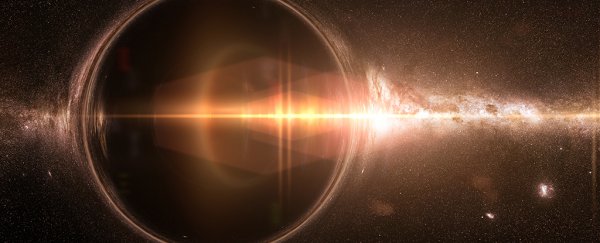Scientists are getting closer to being able to spot Hawking radiation – that elusive thermal radiation thought to be produced by a black hole's event horizon. Just understanding the concept of this radiation is tricky though, let alone finding it.
A new proposal suggests creating a special kind of quantum circuit to act as a 'black hole laser', essentially simulating some of the properties of a black hole. As with previous studies, the idea is that experts can observe and study Hawking radiation without actually having to look at any real black holes.
The basic principle is relatively straightforward. Black holes are objects that warp spacetime so much, not even a wave of light can escape. Swap spacetime for some other material (such as water) and make it flow quickly enough so that waves passing through are too slow to escape, and you've got yourself a fairly rudimentary model.
Many examples can also include a 'white hole' equivalent – a kind of backwards black hole where waves can only escape, but can't enter.
In this newest attempt to design one, researchers propose using a material with a structure not found in nature, one engineered so the particles within it can move faster than the light that passes through.
 An illustration of the black hole laser in the circuit. (Katayama, Scientific Reports, 2021)
An illustration of the black hole laser in the circuit. (Katayama, Scientific Reports, 2021)
"The metamaterial element makes it possible for Hawking radiation to travel back and forth between horizons," says physicist Haruna Katayama from Hiroshima University in Japan.
The aim is to amplify the Hawking radiation enough for it to be measured, and to achieve this Katayama is also using the so-called Josephson effect – a phenomenon where a continuous flow of current is created that doesn't require any voltage.
With the use of the metamaterial and the aid of the Josephson effect, this proposal promises to go beyond previous attempts to theorize what a black hole laser could look like, even if actually putting one together has yet to be done.
Such a circuit could potentially produce what's known as a soliton, the research suggests – a localized and self-reinforcing waveform that's able to hold its speed and shape until the system is broken down by external factors.
"Unlike previously proposed black hole lasers, our version has a black hole/white hole cavity formed within a single soliton, where Hawking radiation is emitted outside of the soliton so we can evaluate it," says Katayama.
Ultimately the system would allow a quantum correlation between two particles – one inside and one outside the event horizon – to be measured mathematically, without having to observe them both simultaneously.
And that is how Hawking radiation is thought to be produced, as entangled particle pairs. Its discovery would get us closer to a unified and circular theory of everything, tying together quantum mechanics and general relativity.
Challenges remain to make this black hole laser a reality, but if scientists are able to configure it correctly, it might not only enable us to observe Hawking radiation – it could give us the tools to control it too, opening up a whole host of new possibilities.
"In the future, we would like to develop this system for quantum communication between distinct spacetimes using Hawking radiation," says Katayama.
The research has been published in Scientific Reports.
